Hyundai Equus 2016 Manual PDF
Manufacturer: HYUNDAI, Model Year: 2016, Model line: Equus, Model: Hyundai Equus 2016Pages: 477, PDF Size: 16.25 MB
Page 71 of 477
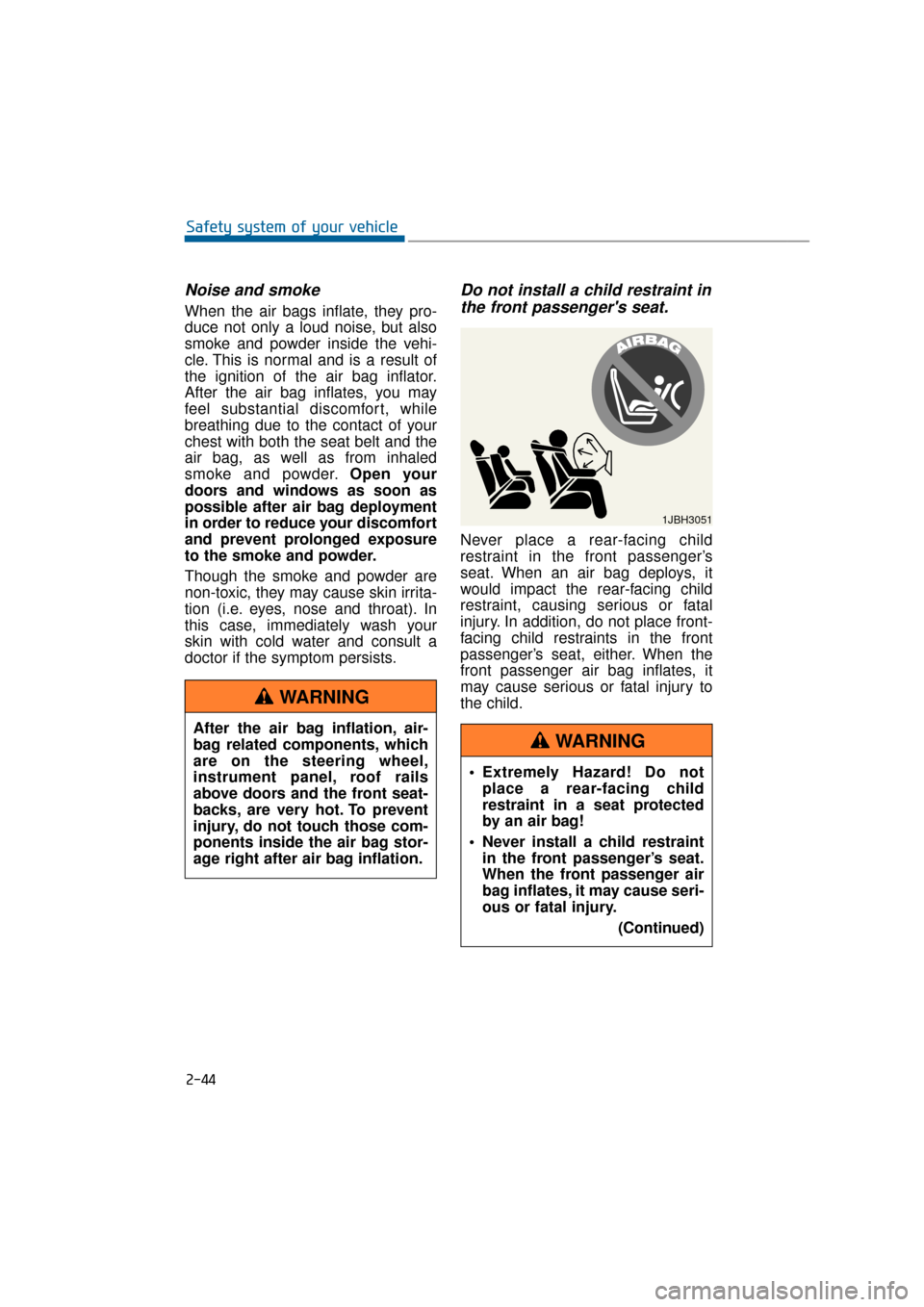
Noise and smoke
When the air bags inflate, they pro-
duce not only a loud noise, but also
smoke and powder inside the vehi-
cle. This is normal and is a result of
the ignition of the air bag inflator.
After the air bag inflates, you may
feel substantial discomfort, while
breathing due to the contact of your
chest with both the seat belt and the
air bag, as well as from inhaled
smoke and powder.Open your
doors and windows as soon as
possible after air bag deployment
in order to reduce your discomfort
and prevent prolonged exposure
to the smoke and powder.
Though the smoke and powder are
non-toxic, they may cause skin irrita-
tion (i.e. eyes, nose and throat). In
this case, immediately wash your
skin with cold water and consult a
doctor if the symptom persists.
Do not install a child restraint in the front passenger's seat.
Never place a rear-facing child
restraint in the front passenger’s
seat. When an air bag deploys, it
would impact the rear-facing child
restraint, causing serious or fatal
injury. In addition, do not place front-
facing child restraints in the front
passenger’s seat, either. When the
front passenger air bag inflates, it
may cause serious or fatal injury to
the child.
2-44
Safety system of your vehicle
After the air bag inflation, air-
bag related components, which
are on the steering wheel,
instrument panel, roof rails
above doors and the front seat-
backs, are very hot. To prevent
injury, do not touch those com-
ponents inside the air bag stor-
age right after air bag inflation.
WARNING
1JBH3051
Extremely Hazard! Do not place a rear-facing child
restraint in a seat protected
by an air bag!
Never install a child restraint in the front passenger’s seat.
When the front passenger air
bag inflates, it may cause seri-
ous or fatal injury.
(Continued)
WARNING
Page 72 of 477
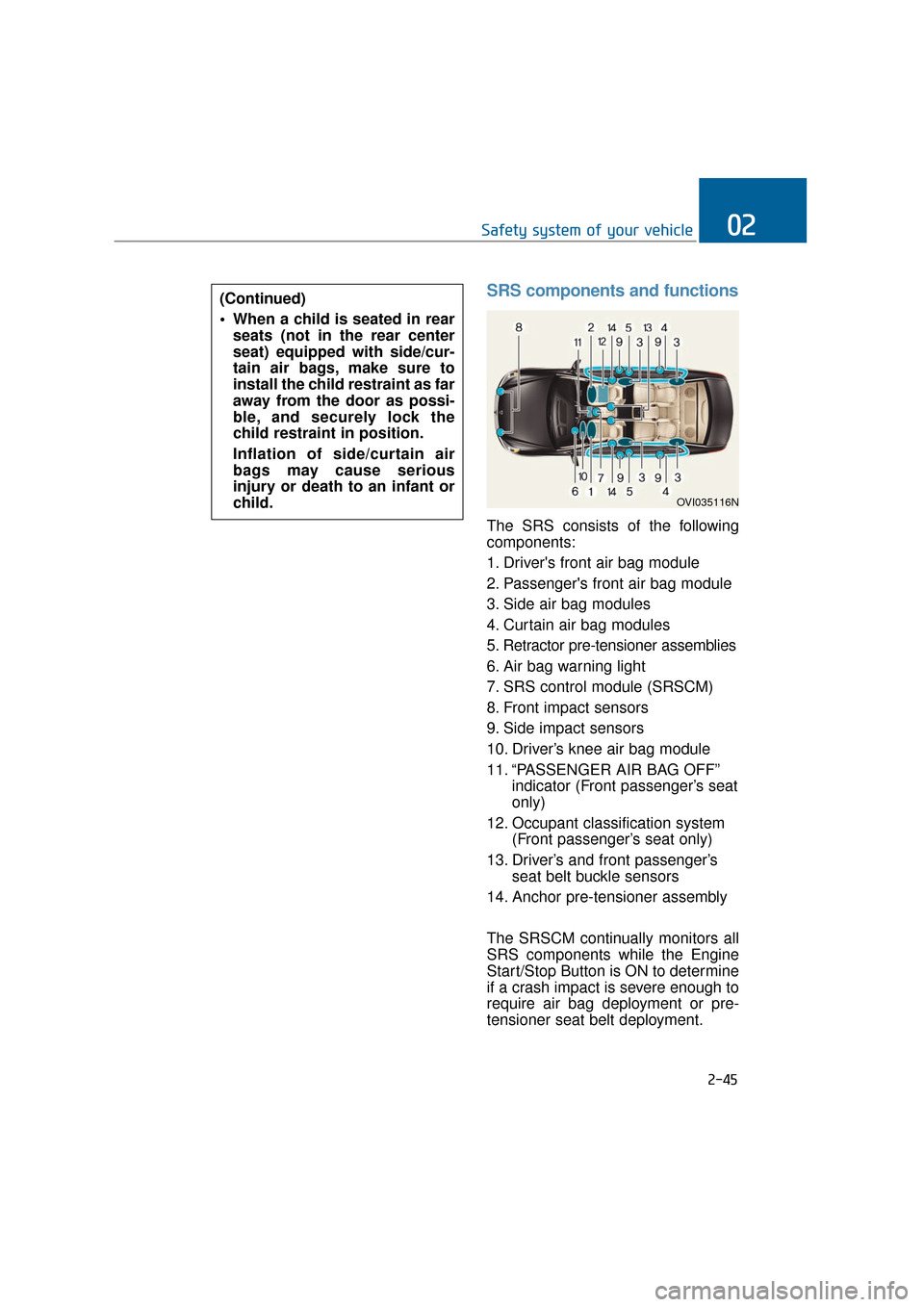
SRS components and functions
The SRS consists of the following
components:
1. Driver's front air bag module
2. Passenger's front air bag module
3. Side air bag modules
4. Curtain air bag modules
5. Retractor pre-tensioner assemblies
6. Air bag warning light
7. SRS control module (SRSCM)
8. Front impact sensors
9. Side impact sensors
10. Driver’s knee air bag module
11. “PASSENGER AIR BAG OFF”indicator (Front passenger’s seat
only)
12. Occupant classification system (Front passenger’s seat only)
13. Driver’s and front passenger’s seat belt buckle sensors
14. Anchor pre-tensioner assembly
The SRSCM continually monitors all
SRS components while the Engine
Start/Stop Button is ON to determine
if a crash impact is severe enough to
require air bag deployment or pre-
tensioner seat belt deployment.
2-45
Safety system of your vehicle02
(Continued)
When a child is seated in rear seats (not in the rear center
seat) equipped with side/cur-
tain air bags, make sure to
install the child restraint as far
away from the door as possi-
ble, and securely lock the
child restraint in position.
Inflation of side/curtain air
bags may cause serious
injury or death to an infant or
child.
OVI035116N
Page 73 of 477
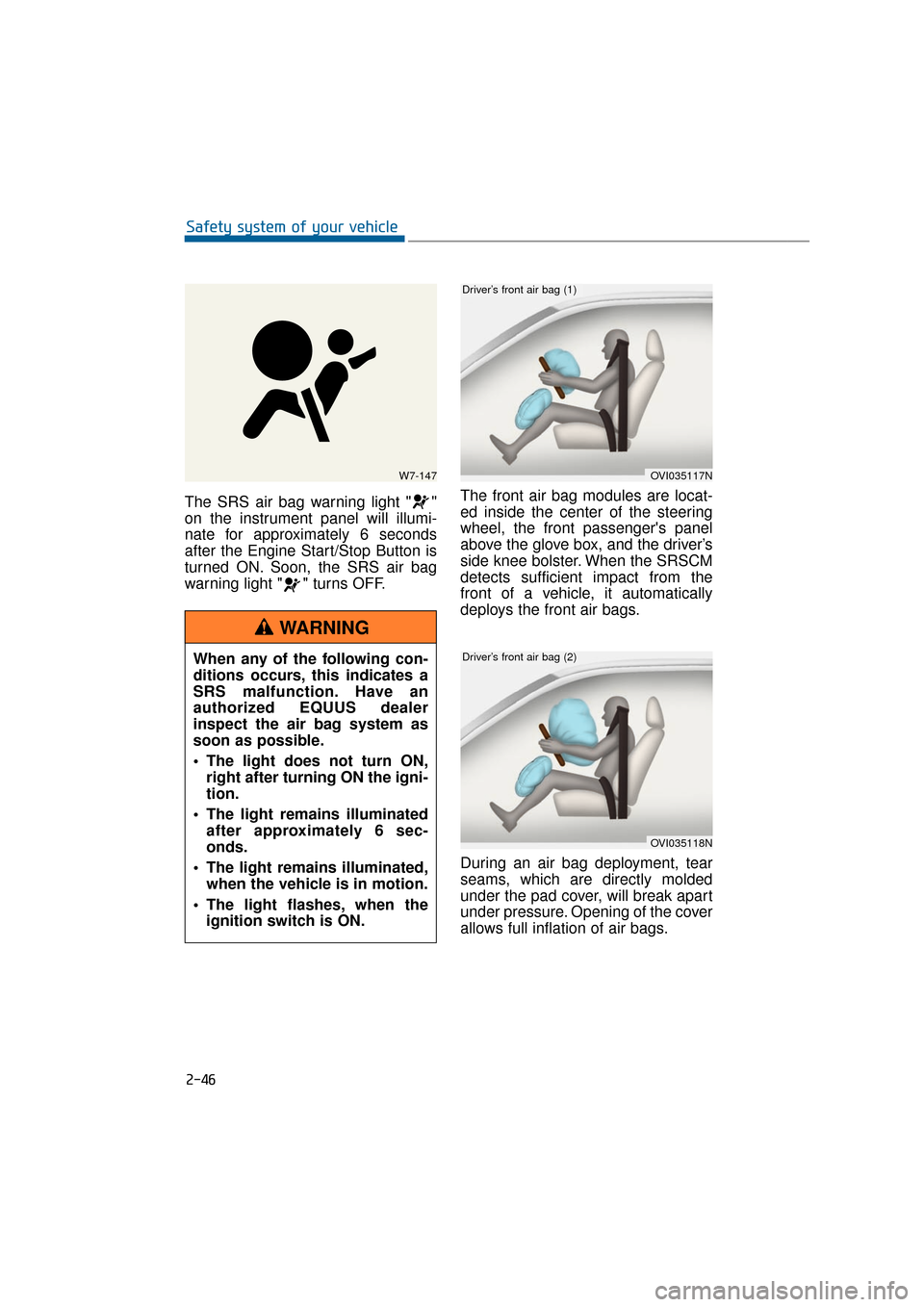
The SRS air bag warning light " "
on the instrument panel will illumi-
nate for approximately 6 seconds
after the Engine Start/Stop Button is
turned ON. Soon, the SRS air bag
warning light " " turns OFF.The front air bag modules are locat-
ed inside the center of the steering
wheel, the front passenger's panel
above the glove box, and the driver’s
side knee bolster. When the SRSCM
detects sufficient impact from the
front of a vehicle, it automatically
deploys the front air bags.
During an air bag deployment, tear
seams, which are directly molded
under the pad cover, will break apart
under pressure. Opening of the cover
allows full inflation of air bags.
2-46
Safety system of your vehicle
W7-147
When any of the following con-
ditions occurs, this indicates a
SRS malfunction. Have an
authorized EQUUS dealer
inspect the air bag system as
soon as possible.
The light does not turn ON,
right after turning ON the igni-
tion.
The light remains illuminated after approximately 6 sec-
onds.
The light remains illuminated, when the vehicle is in motion.
The light flashes, when the ignition switch is ON.
WARNING
OVI035117N
Driver’s front air bag (1)
OVI035118N
Driver’s front air bag (2)
Page 74 of 477
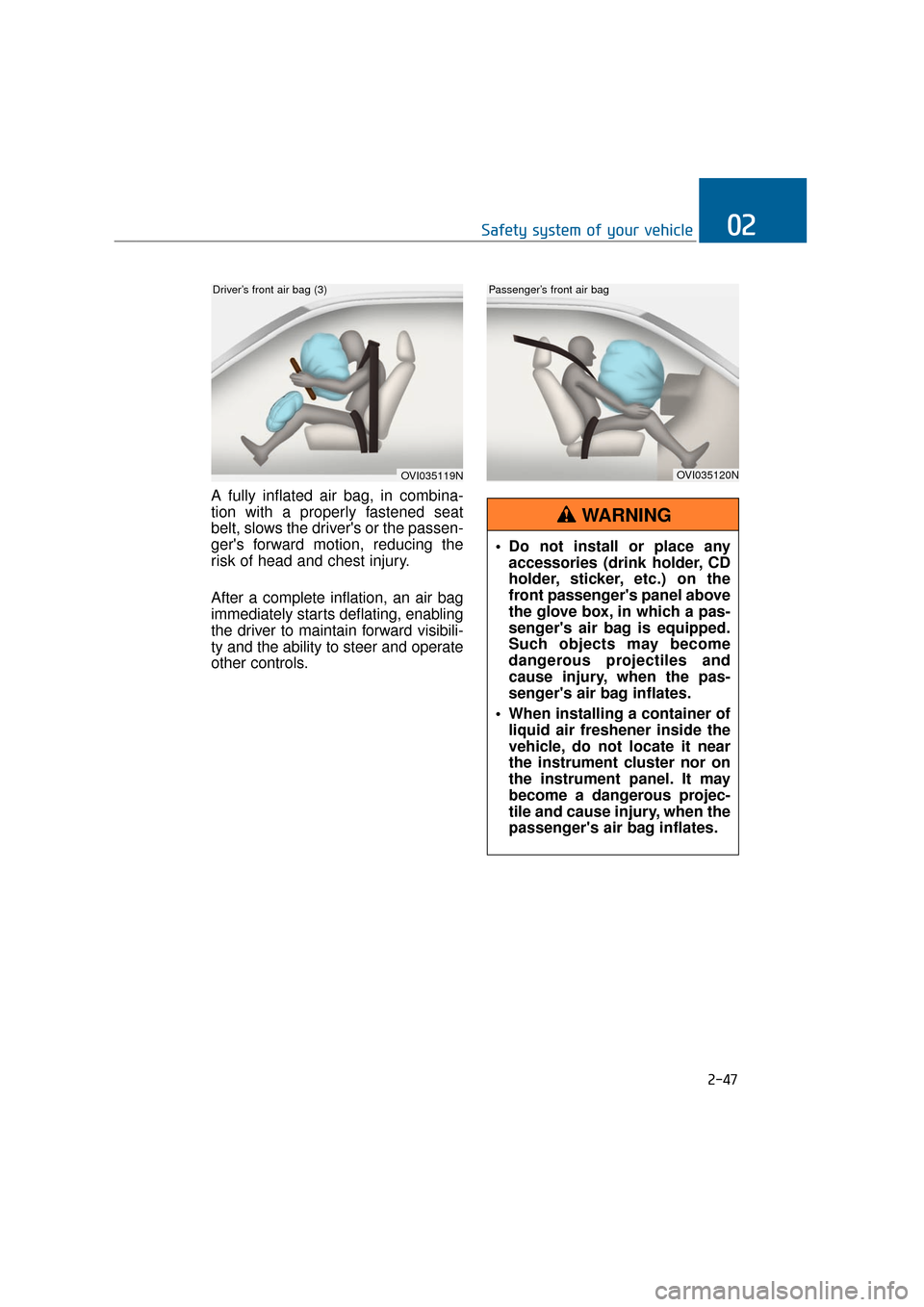
A fully inflated air bag, in combina-
tion with a properly fastened seat
belt, slows the driver's or the passen-
ger's forward motion, reducing the
risk of head and chest injury.
After a complete inflation, an air bag
immediately starts deflating, enabling
the driver to maintain forward visibili-
ty and the ability to steer and operate
other controls.
2-47
Safety system of your vehicle02
OVI035119N
Driver’s front air bag (3)
OVI035120N
Passenger’s front air bag
Do not install or place anyaccessories (drink holder, CD
holder, sticker, etc.) on the
front passenger's panel above
the glove box, in which a pas-
senger's air bag is equipped.
Such objects may become
dangerous projectiles and
cause injury, when the pas-
senger's air bag inflates.
When installing a container of liquid air freshener inside the
vehicle, do not locate it near
the instrument cluster nor on
the instrument panel. It may
become a dangerous projec-
tile and cause injury, when the
passenger's air bag inflates.
WARNING
Page 75 of 477
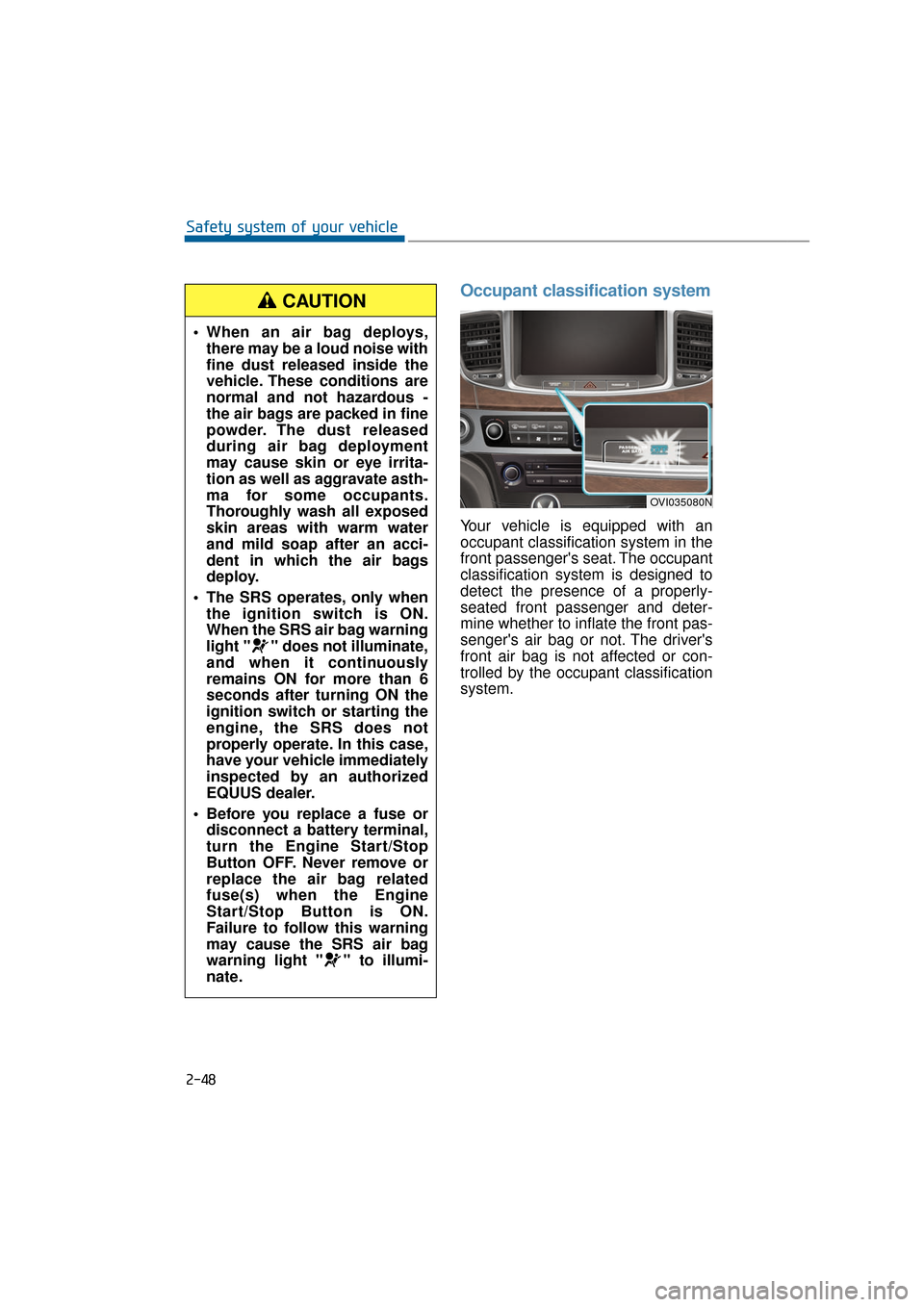
Occupant classification system
Your vehicle is equipped with an
occupant classification system in the
front passenger's seat. The occupant
classification system is designed to
detect the presence of a properly-
seated front passenger and deter-
mine whether to inflate the front pas-
senger's air bag or not. The driver's
front air bag is not affected or con-
trolled by the occupant classification
system.
2-48
Safety system of your vehicle
OVI035080N
When an air bag deploys,there may be a loud noise with
fine dust released inside the
vehicle. These conditions are
normal and not hazardous -
the air bags are packed in fine
powder. The dust released
during air bag deployment
may cause skin or eye irrita-
tion as well as aggravate asth-
ma for some occupants.
Thoroughly wash all exposed
skin areas with warm water
and mild soap after an acci-
dent in which the air bags
deploy.
The SRS operates, only when the ignition switch is ON.
When the SRS air bag warning
light " " does not illuminate,
and when it continuously
remains ON for more than 6
seconds after turning ON the
ignition switch or starting the
engine, the SRS does not
properly operate. In this case,
have your vehicle immediately
inspected by an authorized
EQUUS dealer.
Before you replace a fuse or disconnect a battery terminal,
turn the Engine Start/Stop
Button OFF. Never remove or
replace the air bag related
fuse(s) when the Engine
Start/Stop Button is ON.
Failure to follow this warning
may cause the SRS air bag
warning light " " to illumi-
nate.
CAUTION
Page 76 of 477
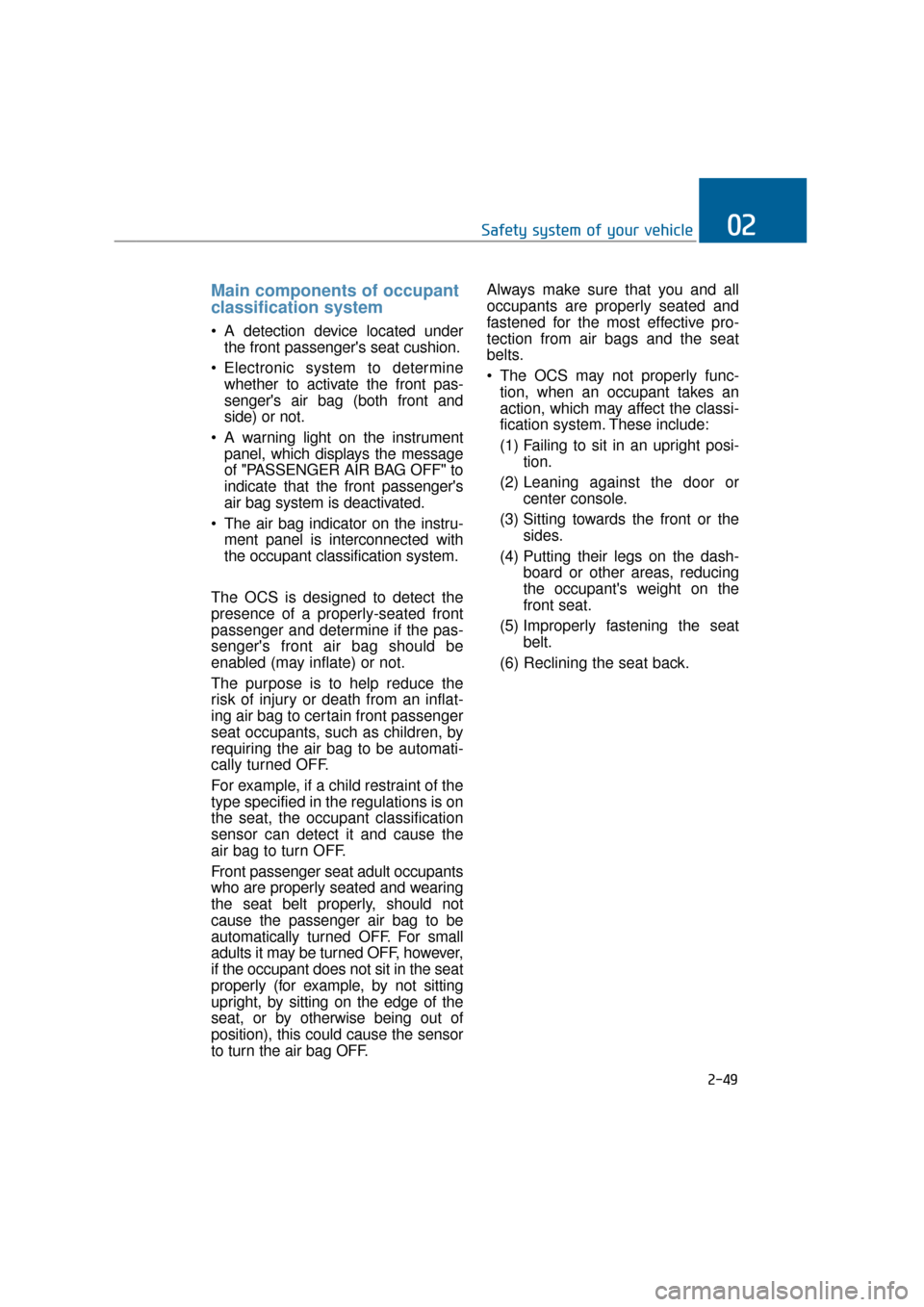
Main components of occupant
classification system
A detection device located underthe front passenger's seat cushion.
Electronic system to determine whether to activate the front pas-
senger's air bag (both front and
side) or not.
A warning light on the instrument panel, which displays the message
of "PASSENGER AIR BAG OFF" to
indicate that the front passenger's
air bag system is deactivated.
The air bag indicator on the instru- ment panel is interconnected with
the occupant classification system.
The OCS is designed to detect the
presence of a properly-seated front
passenger and determine if the pas-
senger's front air bag should be
enabled (may inflate) or not.
The purpose is to help reduce the
risk of injury or death from an inflat-
ing air bag to certain front passenger
seat occupants, such as children, by
requiring the air bag to be automati-
cally turned OFF.
For example, if a child restraint of the
type specified in the regulations is on
the seat, the occupant classification
sensor can detect it and cause the
air bag to turn OFF.
Front passenger seat adult occupants
who are properly seated and wearing
the seat belt properly, should not
cause the passenger air bag to be
automatically turned OFF. For small
adults it may be turned OFF, however,
if the occupant does not sit in the seat
properly (for example, by not sitting
upright, by sitting on the edge of the
seat, or by otherwise being out of
position), this could cause the sensor
to turn the air bag OFF. Always make sure that you and all
occupants are properly seated and
fastened for the most effective pro-
tection from air bags and the seat
belts.
The OCS may not properly func-
tion, when an occupant takes an
action, which may affect the classi-
fication system. These include:
(1) Failing to sit in an upright posi- tion.
(2) Leaning against the door or
center console.
(3) Sitting towards the front or the sides.
(4) Putting their legs on the dash- board or other areas, reducing
the occupant's weight on the
front seat.
(5) Improperly fastening the seat belt.
(6) Reclining the seat back.
2-49
Safety system of your vehicle02
Page 77 of 477
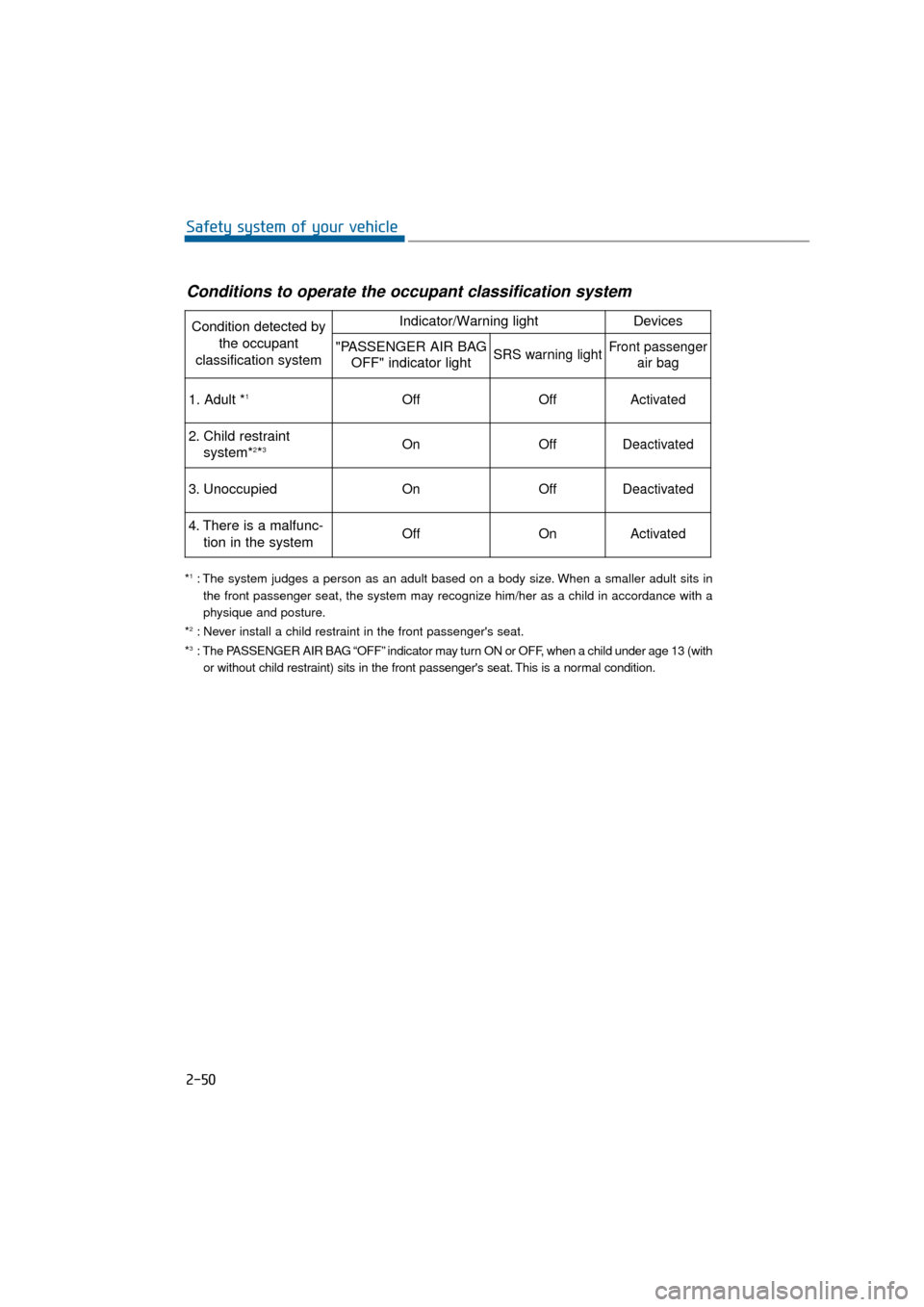
2-50
Safety system of your vehicle
*1: The system judges a person as an adult based on a body size. When a smaller adult sits inthe front passenger seat, the system may recognize him/her as a child in accordance with a
physique and posture.
*
2: Never install a child restraint in the front passenger's seat.
*3: The PASSENGER AIR BAG “OFF” indicator may turn ON or OFF, when a child under age 13 (with or without child restraint) sits in the front passenger's seat. This is a normal condition.
Conditions to operate the occupant classification system
Condition detected by the occupant
classification systemIndicator/Warning lightDevices
"PASSENGER AIR BAG OFF" indicator lightSRS warning lightFront passenger air bag
1. Adult *1OffOffActivated
2. Child restraint
system*2*3OnOffDeactivated
3. Unoccupied OnOffDeactivated
4. There is a malfunc-tion in the systemOffOnActivated
Page 78 of 477
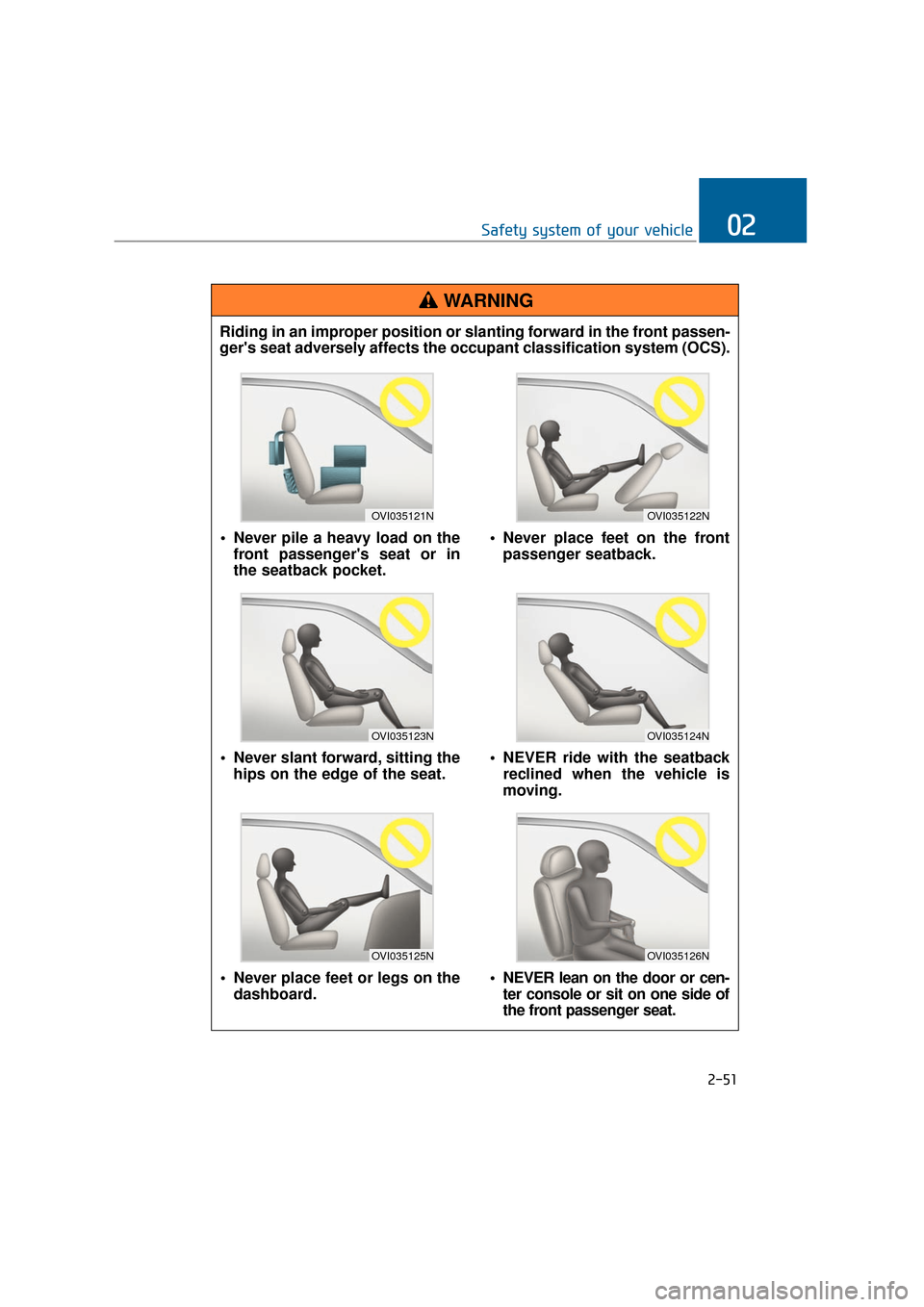
2-51
Safety system of your vehicle02
Riding in an improper position or slanting forward in the front passen-
ger's seat adversely affects the occupant classification system (OCS).
WARNING
Never pile a heavy load on thefront passenger's seat or in
the seatback pocket. Never place feet on the frontpassenger seatback.
Never slant forward, sitting thehips on the edge of the seat. NEVER ride with the seatbackreclined when the vehicle is
moving.
Never place feet or legs on thedashboard. NEVER lean on the door or cen-ter console or sit on one side of
the front passenger seat.
OVI035121NOVI035122N
OVI035124NOVI035123N
OVI035125NOVI035126N
Page 79 of 477
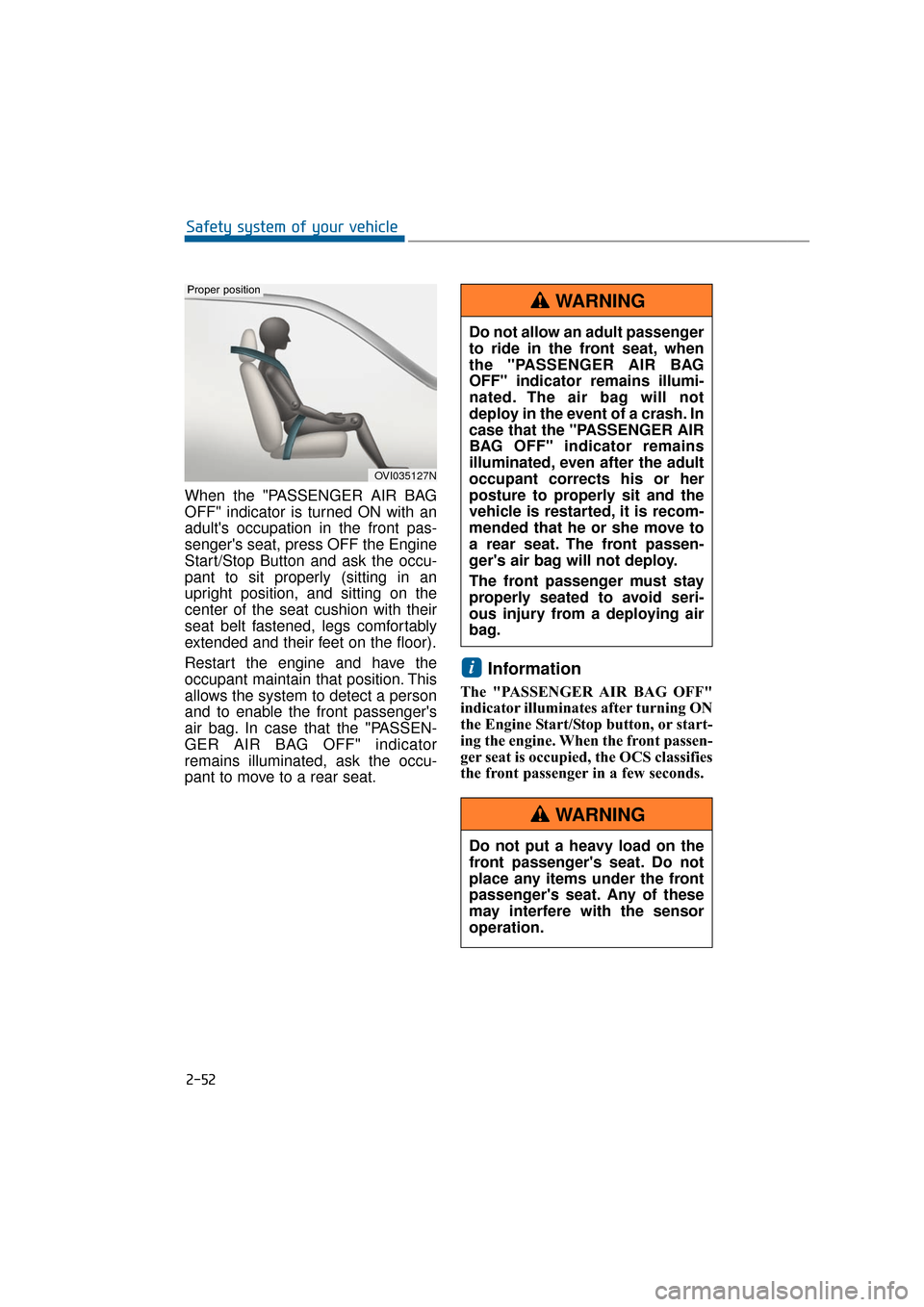
When the "PASSENGER AIR BAG
OFF" indicator is turned ON with an
adult's occupation in the front pas-
senger's seat, press OFF the Engine
Start/Stop Button and ask the occu-
pant to sit properly (sitting in an
upright position, and sitting on the
center of the seat cushion with their
seat belt fastened, legs comfortably
extended and their feet on the floor).
Restart the engine and have the
occupant maintain that position. This
allows the system to detect a person
and to enable the front passenger's
air bag. In case that the "PASSEN-
GER AIR BAG OFF" indicator
remains illuminated, ask the occu-
pant to move to a rear seat.
Information
The "PASSENGER AIR BAG OFF"
indicator illuminates after turning ON
the Engine Start/Stop button, or start-
ing the engine. When the front passen-
ger seat is occupied, the OCS classifies
the front passenger in a few seconds.
i
2-52
Safety system of your vehicle
OVI035127N
Proper position
Do not allow an adult passenger
to ride in the front seat, when
the "PASSENGER AIR BAG
OFF" indicator remains illumi-
nated. The air bag will not
deploy in the event of a crash. In
case that the "PASSENGER AIR
BAG OFF" indicator remains
illuminated, even after the adult
occupant corrects his or her
posture to properly sit and the
vehicle is restarted, it is recom-
mended that he or she move to
a rear seat. The front passen-
ger's air bag will not deploy.
The front passenger must stay
properly seated to avoid seri-
ous injury from a deploying air
bag.
WARNING
Do not put a heavy load on the
front passenger's seat. Do not
place any items under the front
passenger's seat. Any of these
may interfere with the sensor
operation.
WARNING
Page 80 of 477
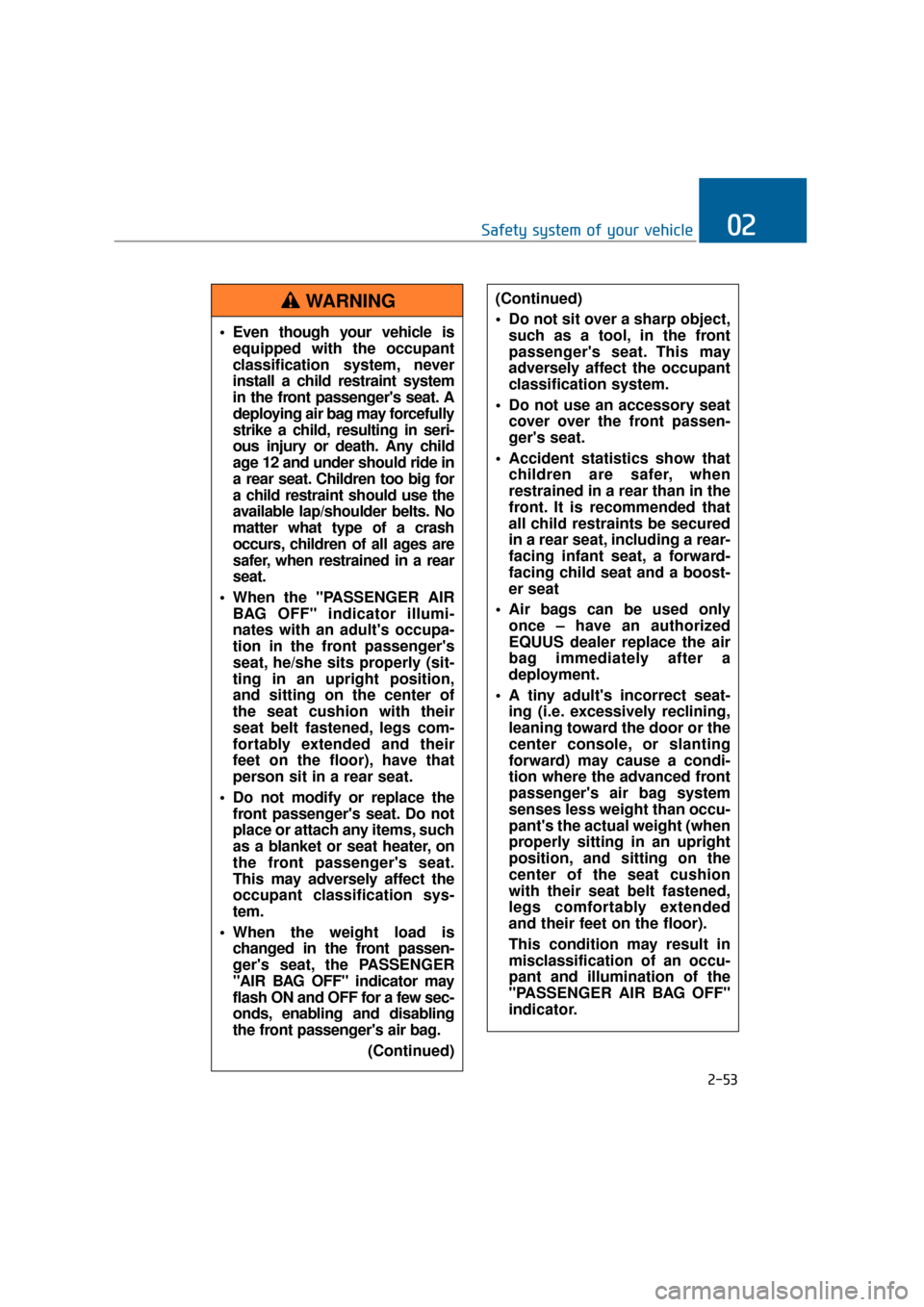
2-53
Safety system of your vehicle02
Even though your vehicle isequipped with the occupant
classification system, never
install a child restraint system
in the front passenger's seat. A
deploying air bag may forcefully
strike a child, resulting in seri-
ous injury or death. Any child
age 12 and under should ride in
a rear seat. Children too big for
a child restraint should use the
available lap/shoulder belts. No
matter what type of a crash
occurs, children of all ages are
safer, when restrained in a rear
seat.
When the "PASSENGER AIR BAG OFF" indicator illumi-
nates with an adult's occupa-
tion in the front passenger's
seat, he/she sits properly (sit-
ting in an upright position,
and sitting on the center of
the seat cushion with their
seat belt fastened, legs com-
fortably extended and their
feet on the floor), have that
person sit in a rear seat.
Do not modify or replace the front passenger's seat. Do not
place or attach any items, such
as a blanket or seat heater, on
the front passenger's seat.
This may adversely affect the
occupant classification sys-
tem.
When the weight load is changed in the front passen-
ger's seat, the PASSENGER
"AIR BAG OFF" indicator may
flash ON and OFF for a few sec-
onds, enabling and disabling
the front passenger's air bag.
(Continued)
(Continued)
Do not sit over a sharp object,such as a tool, in the front
passenger's seat. This may
adversely affect the occupant
classification system.
Do not use an accessory seat cover over the front passen-
ger's seat.
Accident statistics show that children are safer, when
restrained in a rear than in the
front. It is recommended that
all child restraints be secured
in a rear seat, including a rear-
facing infant seat, a forward-
facing child seat and a boost-
er seat
Air bags can be used only once – have an authorized
EQUUS dealer replace the air
bag immediately after a
deployment.
A tiny adult's incorrect seat- ing (i.e. excessively reclining,
leaning toward the door or the
center console, or slanting
forward) may cause a condi-
tion where the advanced front
passenger's air bag system
senses less weight than occu-
pant's the actual weight (when
properly sitting in an upright
position, and sitting on the
center of the seat cushion
with their seat belt fastened,
legs comfortably extended
and their feet on the floor).
This condition may result in
misclassification of an occu-
pant and illumination of the
"PASSENGER AIR BAG OFF"
indicator.WARNING